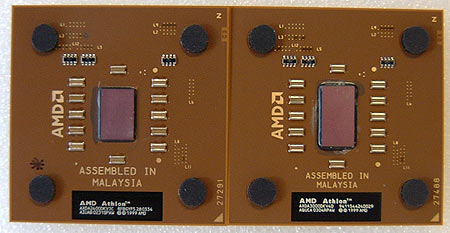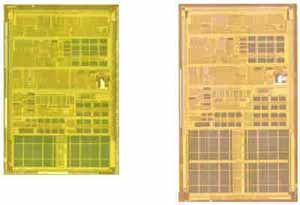AMD AthlonXP 3000+ Barton Processor Review
In the latter half of 2002 all AMD could talk about
was their 64-bit processor, code named "Hammer." With all the Hammer this
and Hammer that, you'd think that it was the next best thing after sliced
bread! Unfortunately for them things did not pan out as they had hoped and
Hammer... well let's just say we're still waiting for it.
Today we'll be testing out AMD's new AthlonXP 3000+
processor which is based on the new Barton core. This the last revision for the
fan favorite K7 Athlon and is a holdover till the K8 Athlon64 is
released.
Unlike the transition from the Palomino core (0.18
micron) to the Thoroughbred (0.13 micron) which was simply a die shrink,
AMD has added something new to the mix this time around. They
have incorporated an extra 256KB of L2 cache into the core, thus giving it a grand
total of 512 KB L2 cache.
In the past we have seen that when a processor
doubles the amount of L2 cache, performance clock for clock usually increases by
around 10%. In the picture below you can see the Thoroughbred core on the left,
and the Barton core on the right.

As
you can see the AthlonXP 3000+ die is physically larger and that's is all due
the doubling of L2. The total transistor count has also increased by around
30%, from 37.6 million present in the Thoroughbred to 54.3 million in the
Barton core. Albeit, both cores are still a smaller than Intel's Northwood Pentium
4 which weighs in at a 55 million transistors.
The AthlonXP 3000+ "Barton"
processor we tested was based on the AQUCA stepping, and was manufactured sometime in week
04 of 2003, literally hot off the presses!
The AthlonXP 3000+ runs on a 333 MHz FSB with a default voltage of 1.65V,
just like the other 333 MHz chips. Other than the larger L2, there are no
architectural differences between Thoroughbred B's and Barton
chips.
 |
| The Thoroughbred core is on
the left with 256KB L2 cache and the Barton core is on the right with
512KB L2 Cache. Both processor cores have a total of 128KB L1
cache. |
Previous limited release [paper] processor launches were severely
criticized by consumer left, right and center. This time around, both Barton
based AthlonXP 2800+ and AthlonXP 3000+ are available immediately. AMD is to
release a "budget" AthlonXP 2500+ Barton at the end of Q1 2003.
As you might have noticed, the top of the line AthlonXP processors
are no longer as cheap as they once were with previous releases. The reason
behind this is, AMD is trying to get price parity for their chips similarly
priced high end Intel Pentium 4's.
Currently the AthlonXP 3000+ has a MSRP
of $588 US which is pretty close to the retail price of the
Intel Pentium 4 3.06 GHz at $617 US.
Either way you
swing it that's a big chunk of change; and I hope this can bring AMD out of the
red after their recent downsize to the tune of near $1 Billion USD.
While Athlon64 (Hammer) motherboards
have been ready since November 2002, the processors themselves are only
scheduled to be released sometime in September 2003. AMD users
better get use to the Barton because we still have quite a wait quite a
bit!
Motherboard
Compatibility
All current 333 MHz capable Socket A chipsets (VIA KT333, KT400,
nVIDIA nForce2, SiS 746FX) should be compatible with Barton based processors
although you may need to flash the BIOS for the processor to be recognized properly.
For those PCstats.com readers with older 133 MHz based motherboards (VIA KT133A,
KT266, KT266A, AMD 760, SiS735, 745, nVIDIA nForce) the chipsets do
support the Barton core (not 333 MHz), but it will be up to the manufacturers
if they want to give support for the processor or not. Bottom line, today might
be a good day to upgrade you BIOS if the AthlonXP 3000+ is in your
sights.

